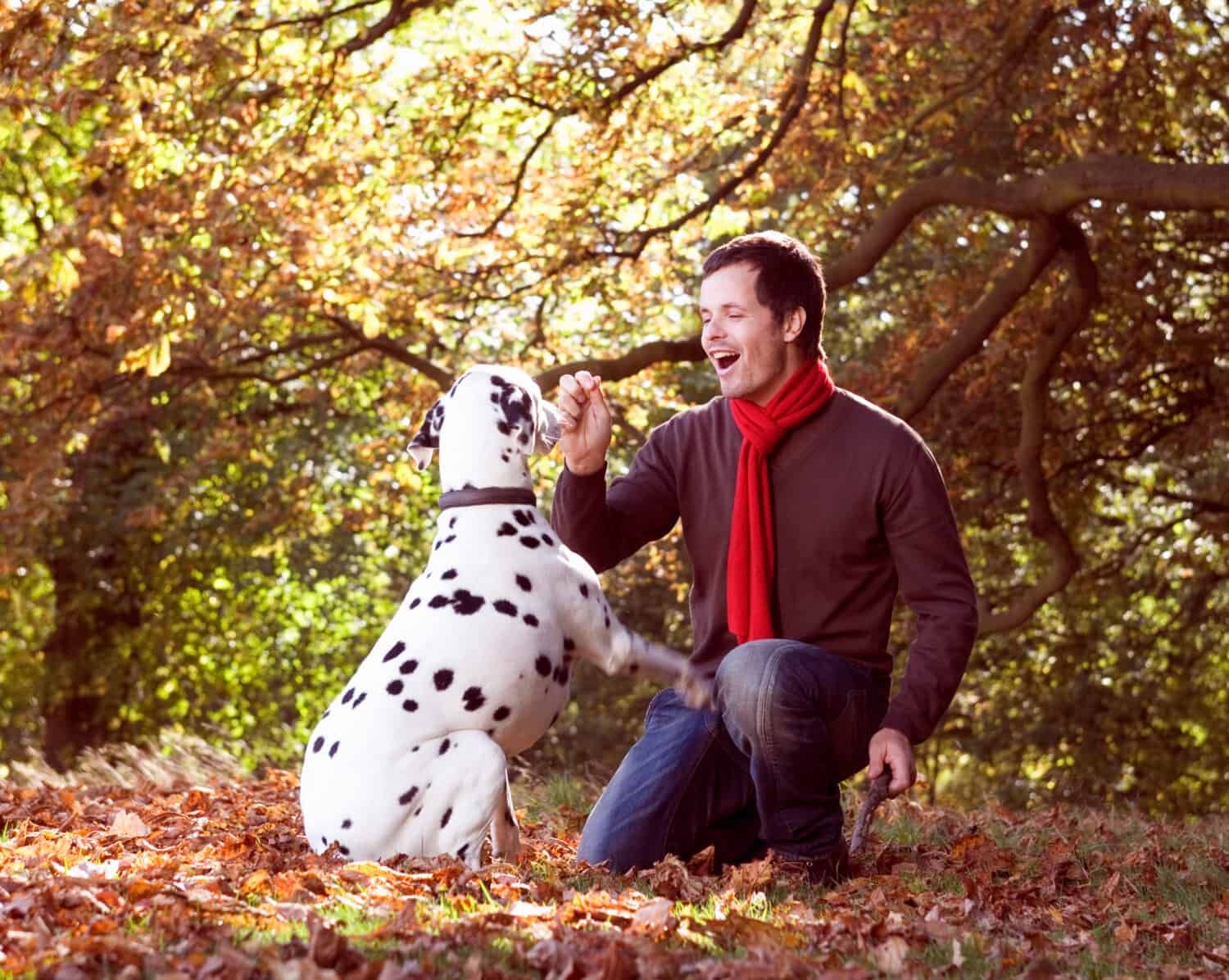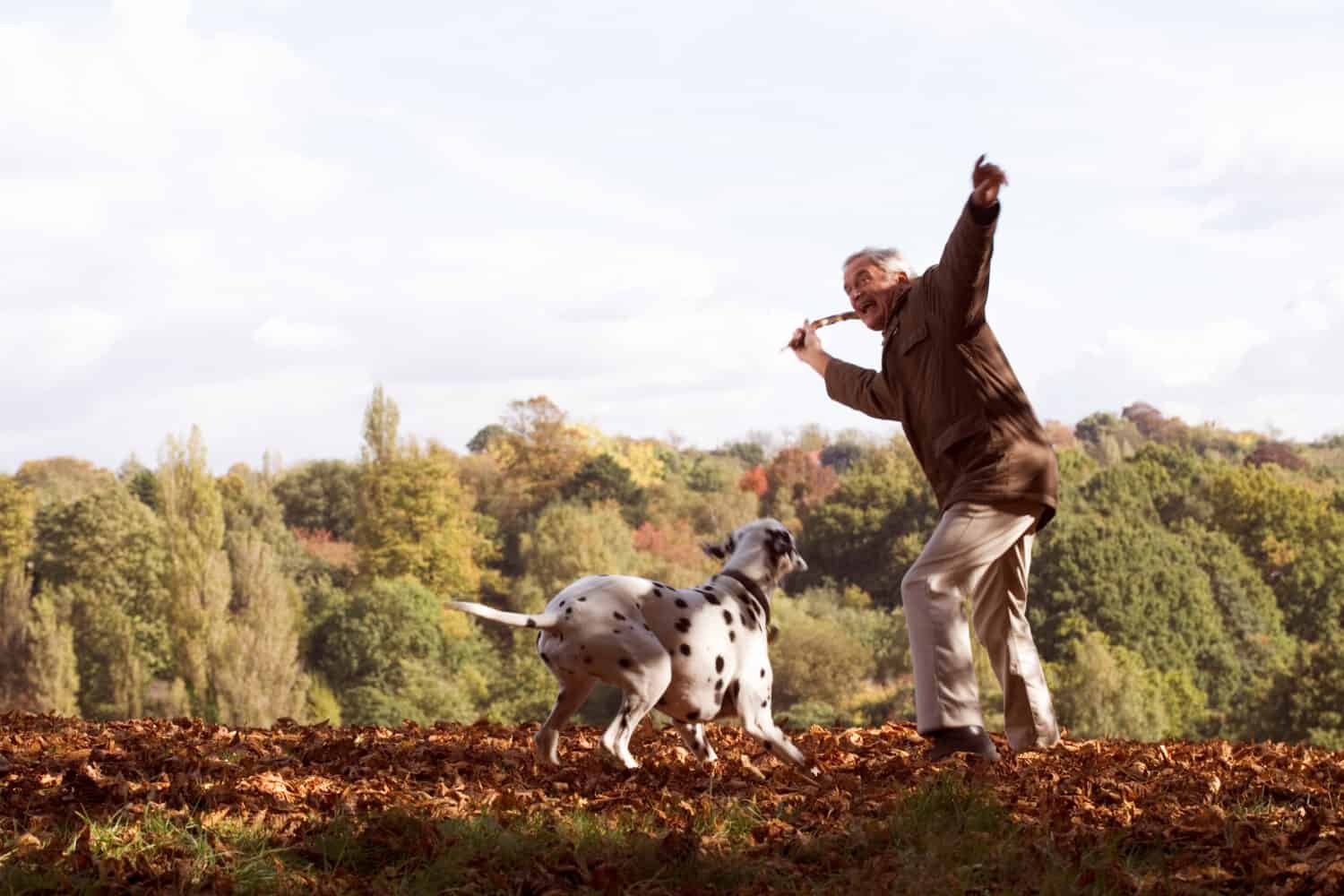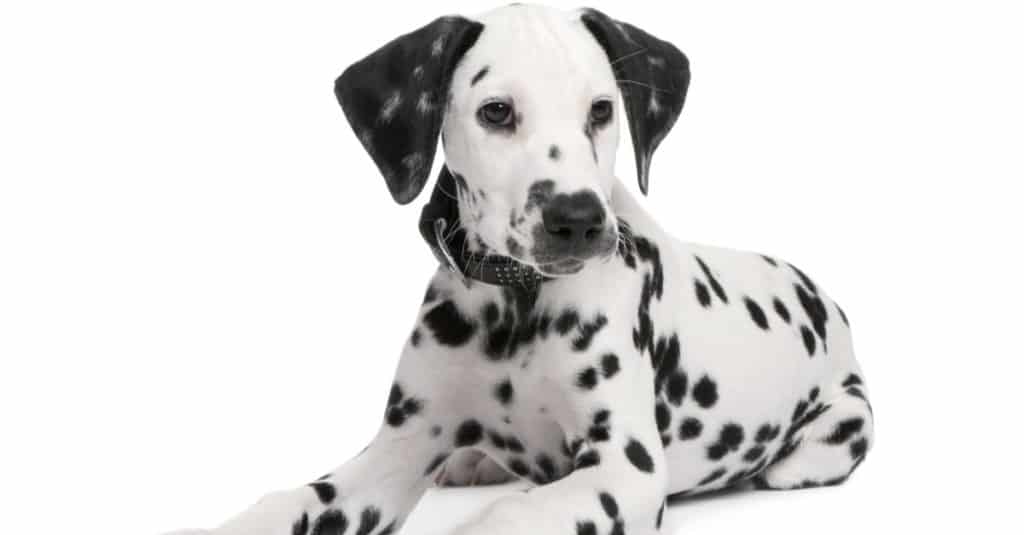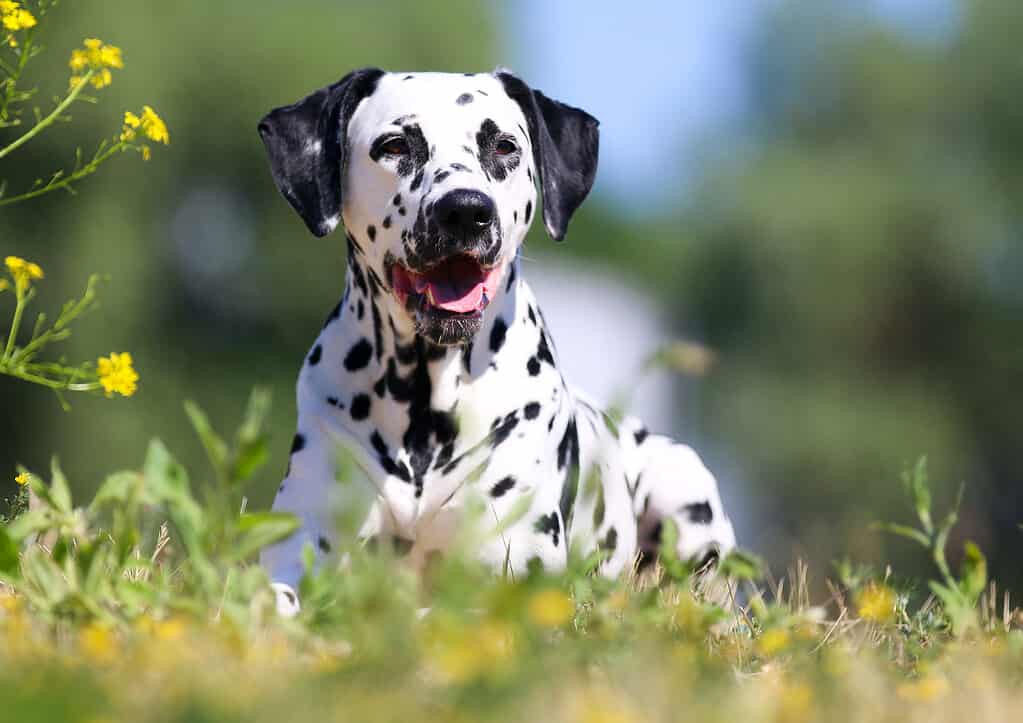Preparing to bring home a Dalmatian puppy? You’ll want to make sure you have as much info as possible to provide a loving, safe, enriching, and supportive home for your new puppy.
Read on to learn all about Dalmatian progression, what to know about ethically raising your puppy, and what to expect from their growth and developmental milestones.
Dalmatian: Breed Summary
This history of the Dalmatian is, like the coat of this breed, a bit spotty. While some breeds have quite traceable genetic paths that help us understand their ancestral lineages, the ancestry of Dalmatians is rather hazy.
According to the AKC, although Dalmatians are grouped genetically among retrievers, they don’t strongly line up with any established modern breeds. This points to the Dalmatian having quite ancient roots.
The origin of the name, Dalmatian, is also a bit of a mystery. Some historians believe the name may be connected to the word “Damachien”, which is a combination of the French words dama (meaning fallow deer) and chien (meaning dog). Some canine historians believe this breed’s ancestral roots can be traced to the Greek island of Crete in 400 BC with the crossing of a Cretan hound and a Bahakaa dog.
This ancient cross hunted deer and worked alongside horses, which, interestingly is a working trait often associated with the modern Dalmatian. In the 16th century, the Dalmatian made its way to England, likely from southern Europe. From there, the popularity of the breed spread, primarily as deer hunters and horse-and-buggy accompaniers. The link between Dalmatians and fire departments is traced back to this work with horse-drawn carriages, as these departments in England initially worked via horse-drawn fire wagons. By the 1800s, Dalmatians started to appear in the US.
Attributes and Breed Standards
Genetics is one part of what may influence the attributes and behaviors of a dog. While genetics is only a part of a larger picture of a dog’s personality that includes environment, learning, upbringing by the mother dog and humans, early experiences, etc., it can have some role in shaping attributes and characteristics.
For Dalmatians, genetics may play a role in characteristics often associated with this breed such as being energetic, sensitive, athletic, and alert.
According to the AKC, breed standards for Dalmatians include the following:
- A distinctively spotted, glossy, and sleek coat comprised of a white coat with well-rounded black or liver spots that are evenly distributed, minimally mingling, and varying in size from a dime to a half-dollar.
- A well-proportioned head, a nicely arched neck that blends smoothly into the chests and shoulders, and a smooth, level topline.
- An alert, intelligent expression with eyes that are set moderately apart, medium-sized, and somewhat rounded. Accepted eye colors are brown, blue, or a combination.
- An overall poised, alert, engaging, symmetrical, and athletic appearance.

Dalmatians have a white coat with black or liver spots.
©iStock.com/Irina Nedikova
Dalmatian Progression: Growth Chart
Below, we’ve included an average growth chart for healthy Dalmatians from 8 weeks to 2 years of age. Please note that this chart is an estimate and that periodic vet checks are your best way to ensure your individual puppy is properly developing. According to the AKC breed standards, both male and female adult Dalmatians have the same weight range.
| Dalmatian Age | Dalmatian Weight |
|---|---|
| 2 Months | 12-22 lbs |
| 3 Months | 15-27 lbs |
| 4 Months | 20-38 lbs |
| 5 Months | 23-44 lbs |
| 6 Months | 26-49 lbs |
| 7 Months | 28-52 lbs |
| 8 Months | 30-55 lbs |
| 9 Months | 32-57 lbs |
| 10 Months | 34-58 lbs |
| 11 Months | 38-59 lbs |
| 12 Months | 40-60 lbs |
| 18 Months | 42-65 lbs |
| 24 Months | 45-70 lbs |
When Will My Dalmatian Stop Growing?
As a medium to large-sized breed, your Dalmatian pup will likely reach their full size by 18-24 months. Likely, they will reach their full height at 12 months and full weight between 18-24 months old. As you’ll note on the growth chart, there’s quite a range for the healthy weight of an adult Dalmatian.
Make sure that you’re paying attention to how your specific Dalmatian puppy is filling out as they grow. You can bring your puppy to periodic vet checkups (some of which can correspond with vaccine appointments) at the 2,3,4,6,9,12,18, and 24-month mark to ensure your Dalmatian is developing properly.
Dalmatian Progression: How Big Will My Dalmatian Be When Fully Grown?
The AKC-accepted adult weight range for Dalmatians is 45-70 lbs. They should stand between 19-24 inches tall at the withers. Please note that you may see variations from the standard due to genetics.

Your liver or black-spotted Dalmatian should weigh 45-70 lbs when fully grown.
©iStock.com/Eudyptula
When Should My Dalmatian Be Spayed or Neutered?
The question of when or if to spay or neuter your pup is best answered at the breed and individual level. Spaying and neutering can reduce or eliminate the risk of the development of a few reproductive cancers. Additionally, it also ensures your dog doesn’t have puppies and worsen the crisis shelter dogs face in countries like the US where over 400,000 shelter dogs are euthanized every year.
However, research in the past decade has highlighted concerns about how spaying and neutering, especially under 1 year of age, may increase the risk of dogs developing a host of health problems from certain cancers to joint and bone developmental diseases. A large study by the University of California of 35 breeds found that large breeds are especially at risk of developing a number of health conditions from early spay and neuter. Joint disorders for several larger breeds include hip dysplasia, cranial cruciate ligament tear or rupture, and elbow dysplasia.
This study did not include Dalmatians as they are a bit rarer of a breed these days. However, since Dalmatians can grow up to 70 lbs, we recommend consulting with a vet who is informed and up-to-date on the latest research on altering dogs for their professional advice on the safest age to spay or neuter your Dalmatian.
Dalmatian Progression: When Should I Potty Train My Dalmatian Puppy?
You can begin potty training your Dalmatian puppy at 8 weeks old. At this age, your puppy can only hold their bowels and bladder for two hours max. So, to be successful in your training, make sure to take them outside before this 2-hour mark.
Give lots of praise when your pup goes to the bathroom outside or on their puppy pad. You’ll want to associate your puppy going to the bathroom in the appropriate spots with only good things.

Make sure to take your Dalmatian puppy outside frequently for successful potty training.
©iStock.com/animalinfo
If Your Dalmatian Puppy Has an Accident Indoors
If your Dalmatian puppy has an accident, it’s crucial to not punish them or make them feel fearful. Punishment will damage your bond, doesn’t teach your puppy what you’d like them to do, and can teach your puppy that you are someone to be wary of. They can also begin hiding where they go inside because they’ve learned they are not safe to go to the bathroom around you. So, instead of punishment, simply take them outside more often and make sure to give lots of praise, snuggles, toys, and treats when they go in the right spot.
When Should My Dalmatian Stop Eating Puppy Food?
Puppy food is specifically formulated to support the developmental needs of a growing pup. As such, it’s crucial to not switch them over to adult food too early as this can cause a range of issues including the development of joint and bone conditions.
If your Dalmatian is on track to weighing closer to that 70 lb mark when fully grown, you can start transitioning them to adult food around 14-18 months of age. For smaller Dalmatians, you can start the switch between 12-14 months old. If in doubt, you can check with a veterinary nutritionist to make sure you’re on the right track for your specific pup.
Dalmatian Progression: When Will My Dalmatian Start Losing Teeth?
Your Dalmatian puppy will start to lose their set of 28 puppy teeth at around 16 weeks old. Between the 4-6 month mark, these baby teeth will fall out and be replaced by a set of 42 adult teeth.
This process can be quite a bit uncomfortable for your Dalmatian puppy, and they will look for items to chew to soothe their sore gums. The best thing you can do to support your pup during this time is to provide them with toys of various textures.
Trade, Don’t Take and Management Tips During Teething Stage
Having toys available in every room that your puppy has access to will help ensure that they chew the toys rather than your shoes. You will also likely need to make sure that you put your valuable items out of reach as much as possible. Additionally, make sure there aren’t dangerous items such as electrical wires accessible to your puppy. You may need to gate off certain areas of the house.
If you find that your puppy is chewing something inappropriate, make sure to trade them for an appropriate item. This will teach your puppy that you are safe to give items to because you will always give them something as good or better in return. If you only take away items from your Dalmatian puppy, your puppy may feel unsafe around you when they have something and develop habitual resource-guarding behaviors.
Dalmatian Progression: When Should I Start Training My Dalmatian?
One of the first questions you might be asking is when you should start training your Dalmatian puppy. While teaching your puppy cues that will help them navigate our human world is important, ethical, gentle training is only part of raising a puppy.
In recent years, companion canine researchers and advocates have been bringing to light the vast importance of prioritizing facilitating a secure attachment-style bond with your puppy. This bond teaches your puppy that you are their safe pillar of support, comfort, and guidance. Knowing that you are a consistently safe, grounding presence in their life will help your puppy feel confident in processing and engaging with the world around them.
So, while you can begin teaching your puppy cues such as “come” starting at 8 weeks old, please make sure to prioritize building this vital bond.
Additionally, it’s crucial to understand that training doesn’t take the place of providing for your dog’s species-specific and individual needs throughout their life. Much of what people may label as “behavioral issues” in dogs are a result of unmet needs, a lack of choice, and communication from the dog not being listened to.

Positive reinforcement training is one part of raising your Dalmatian.
©Air Images/Shutterstock.com
What Are Some Core Needs of My Dalmatian?
All sentient beings benefit from having choice and autonomy in their lives. Of course, there are unfortunately many ways in which we have to restrict the lives of our dogs in order to survive our human-dominated world. However, we should still be striving to provide as much choice in their lives as possible. Just like us, dogs suffer emotionally, mentally, and physically when denied agency. For dogs, this suffering often manifests as what folks tend to call “behavior problems”.
So, what are the ways you can incorporate choice and agency in your Dalmatian’s life? With safety in mind, some examples include allowing as much freedom of movement as possible, choice in engaging or disengaging from social interactions and touch, choice in path direction and duration of walks, what toys they play with, the ability to engage or disengage from training sessions, implementing cooperative care, etc.
Other core needs for your Dalmatian include:
- Voluntary and joyful exercise.
- Meaningful mental and emotional enrichment.
- Fear-free, aversive-free training
- Cooperative care as much as possible at home and at the vet.
- Play
- Social bonding (depending on the individual, this may be with people and other dogs, only some people but not dogs, etc.).
- Having their communication listened to (for example: understanding a growl as communication and seeking to help the dog feel safer rather than punishing the growl and suppressing communication).
- Species-appropriate food.
- Restorative rest of at least 12-14 hours a day.

Play is a core need for dogs, including Dalmatians.
©Juice Flair/Shutterstock.com
What Cues Should I Teach My Dalmatian First?
Keeping in mind everything discussed above, there are a couple of cues that are a great idea to introduce to your Dalmatian puppy. Training should always be a rewarding experience for your puppy. Education is ideally innately rewarding for your pup, but you can also use external rewards such as treats, toys, snuggles, and play as part of teaching your puppy. Punishment and aversive tools and techniques shouldn’t be a part of teaching our dogs.
One of the first cues you can begin teaching your Dalmatian puppy is the recall word “come”. When we prioritize building a strong secure attachment bond with our puppy, they will be much more likely to consistently and reliably recall because they want to be with us. Establishing a great recall works best when we don’t punish, trade rather than just take, don’t consistently use recall to end play or social interactions, and are invested in our dog’s interests. In other words, establish a relationship in which you call your puppy to come to you and they do so the vast majority of the time because y’all are such great pals.
Dalmatian Progression: When Will My Dalmatian Calm Down?
Your Dalmatian will likely reach social maturity around 3 years of age. At this point, they have grown from puppyhood and adolescence into their social and physical maturity.
Please note that it’s absolutely paramount to provide for your dog’s species, breed, and individual-specific needs throughout their life to support their ability to feel calm and content. If you are noticing your Dalmatian has difficulty settling or displays hyperarousal symptoms or concerning repetitive behaviors a vet check and behaviorist consultation is in order. Your canine companion may be experiencing pain, an illness, or has chronically unmet needs that disallows their nervous system from regulating and settling.
Common Health Issues Your Dalmatian Might Experience
Pure-bred Dalmatians are genetically prone to being at higher risk for a number of conditions. This includes the following:
- Deafness
- Hip dysplasia
- Epilepsy
- Urinary conditions
- Liver disease
- Dental disease
- Cutaneous hemangiosarcoma
- Solar keratitis (inflammation from sunburn)
Some of these conditions may come with obvious clinical signs such as epilepsy. Others, such as hip dysplasia may accumulate over time. If you are noticing any sudden changes in your pet’s behavior, appetite, gait, energy levels, etc. please set them up for a vet appointment.
Picture of Dalmatian as a Puppy

Adorable Dalmatian puppies play in a yard.
©iStock.com/Bigandt_Photography
Picture of a 6-Month-Old Dalmatian

A 6-month-old Dalmatian with an alert, friendly expression.
©Eric Isselee/Shutterstock.com
Picture of an Adult Dalmatian

An adult Dalmatian enjoying a pleasant day outside.
©Lisjatina/Shutterstock.com
Bonus: 10 Fun Dalmatian Facts
Check out 10 interesting facts about everybody’s favorite spotted dog – the Dalmatian!

The photo featured at the top of this post is © Beth James/Shutterstock.com
Ready to discover the top 10 cutest dog breeds in the entire world?
How about the fastest dogs, the largest dogs and those that are -- quite frankly -- just the kindest dogs on the planet? Each day, AZ Animals sends out lists just like this to our thousands of email subscribers. And the best part? It's FREE. Join today by entering your email below.
Thank you for reading! Have some feedback for us? Contact the AZ Animals editorial team.






